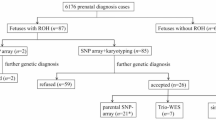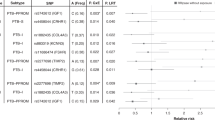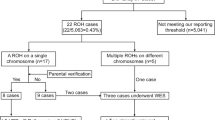Abstract
Background:
Runs of homozygosity (ROH) are consecutive homozygous genotypes, which may result from population inbreeding or consanguineous marriages. ROH enhance the expression of recessive traits.
Methods:
We mapped ROH in a case control study of women delivering at term compared with women delivering at or before 34 wk gestation. Gene sets known to be important in risk of preterm birth were examined for their overlap with identified ROH segments.
Results:
While we found no evidence of increased burden of ROH or copy number variations in mothers delivering at or before 34 wk compared with term, we identified 424 genome-wide 50 kb segments with significant difference in abundance of overlapping ROH segments in cases vs. controls, P < 0.05. These regions overlap 199 known genes. We found preterm birth associated genes (CXCR4, MYLK, PAK1) and genes shown to have an evolutionary link to preterm (CXCR4, PPP3CB, C6orf57, DUSP13, and SLC25A45) with significant differences in abundance of overlapping ROH blocks in cases vs. controls, P < 0.001.
Conclusion:
We conclude, while we found no significant burden of ROH, we did identify genomic regions with significantly greater abundance of ROH blocks in women delivering preterm that overlapped genes known to be involved in preterm birth.
Similar content being viewed by others
Log in or create a free account to read this content
Gain free access to this article, as well as selected content from this journal and more on nature.com
or
References
McQuillan R, Leutenegger AL, Abdel-Rahman R, et al. Runs of homozygosity in European populations. Am J Hum Genet 2008;83:359–72.
Szpiech ZA, Xu J, Pemberton TJ, et al. Long runs of homozygosity are enriched for deleterious variation. Am J Hum Genet 2013;93:90–102.
Muglia LJ, Katz M. The enigma of spontaneous preterm birth. N Engl J Med 2010;362:529–35.
Crider KS, Whitehead N, Buus RM. Genetic variation associated with preterm birth: a HuGE review. Genet Med 2005;7:593–604.
Pennell CE, Jacobsson B, Williams SM, et al.; PREBIC Genetics Working Group. Genetic epidemiologic studies of preterm birth: guidelines for research. Am J Obstet Gynecol 2007;196:107–18.
Plunkett J, Muglia LJ. Genetic contributions to preterm birth: implications from epidemiological and genetic association studies. Ann Med 2008;40:167–95.
Boyd HA, Poulsen G, Wohlfahrt J, Murray JC, Feenstra B, Melbye M. Maternal contributions to preterm delivery. Am J Epidemiol 2009;170:1358–64.
Clausson B, Lichtenstein P, Cnattingius S. Genetic influence on birthweight and gestational length determined by studies in offspring of twins. BJOG 2000;107:375–81.
Treloar SA, Macones GA, Mitchell LE, Martin NG. Genetic influences on premature parturition in an Australian twin sample. Twin Res 2000;3:80–2.
Ward K, Argyle V, Meade M, Nelson L. The heritability of preterm delivery. Obstet Gynecol 2005;106:1235–9.
Witkin SS, Vardhana S, Yih M, Doh K, Bongiovanni AM, Gerber S. Polymorphism in intron 2 of the fetal interleukin-1 receptor antagonist genotype influences midtrimester amniotic fluid concentrations of interleukin-1beta and interleukin-1 receptor antagonist and pregnancy outcome. Am J Obstet Gynecol 2003;189:1413–7.
Little J. Invited commentary: maternal effects in preterm birth–effects of maternal genotype, mitochondrial DNA, imprinting, or environment? Am J Epidemiol 2009;170:1382–5.
Svensson AC, Sandin S, Cnattingius S, et al. Maternal effects for preterm birth: a genetic epidemiologic study of 630,000 families. Am J Epidemiol 2009;170:1365–72.
Weinberg CR, Shi M. The genetics of preterm birth: using what we know to design better association studies. Am J Epidemiol 2009;170:1373–81.
Johnstone F, Inglis L. Familial trends in low birth weight. Br Med J 1974;3:659–61.
Mumtaz G, Nassar AH, Mahfoud Z, et al. Consanguinity: a risk factor for preterm birth at less than 33 weeks’ gestation. Am J Epidemiol 2010;172:1424–30.
Obeidat BR, Khader YS, Amarin ZO, Kassawneh M, Al Omari M. Consanguinity and adverse pregnancy outcomes: the north of Jordan experience. Matern Child Health J 2010;14:283–9.
Wang K, Li M, Hadley D, et al. PennCNV: an integrated hidden Markov model designed for high-resolution copy number variation detection in whole-genome SNP genotyping data. Genome Res 2007;17:1665–74.
Uzun A, Dewan AT, Istrail S, Padbury JF. Pathway-based genetic analysis of preterm birth. Genomics 2013;101:163–70.
Lynch VJ, Leclerc RD, May G, Wagner GP. Transposon-mediated rewiring of gene regulatory networks contributed to the evolution of pregnancy in mammals. Nat Genet 2011;43:1154–9.
Abbas HA, Yunis K. The effect of consanguinity on neonatal outcomes and health. Hum Hered 2014;77:87–92.
Bellad MB, Goudar SS, Edlavitch SA, et al. Consanguinity, prematurity, birth weight and pregnancy loss: a prospective cohort study at four primary health center areas of Karnataka, India. J Perinatol 2012;32:431–7.
Gamsiz ED, Viscidi EW, Frederick AM, et al. Intellectual disability is associated with increased runs of homozygosity in simplex autism. Am J Hum Genet 2013;93:103–109.
Stephen GL, Lui S, Hamilton SA, et al. Transcriptomic profiling of human choriodecidua during term labor: inflammation as a key driver of labor. Am J Reprod Immunol 2015;73:36–55.
Rzepka R, Dołęgowska B, Rajewska A, Kwiatkowski S. On the significance of new biochemical markers for the diagnosis of premature labour. Mediators Inflamm 2014;2014:251451.
Jaleel MA, Tsai AC, Sarkar S, Freedman PV, Rubin LP. Stromal cell-derived factor-1 (SDF-1) signalling regulates human placental trophoblast cell survival. Mol Hum Reprod 2004;10:901–9.
Hamilton SA, Tower CL, Jones RL. Identification of chemokines associated with the recruitment of decidual leukocytes in human labour: potential novel targets for preterm labour. PLoS One 2013;8:e56946.
Marvin KW, Keelan JA, Eykholt RL, Sato TA, Mitchell MD. Use of cDNA arrays to generate differential expression profiles for inflammatory genes in human gestational membranes delivered at term and preterm. Mol Hum Reprod 2002;8:399–408.
Moore F, Da Silva C, Wilde JI, Smarason A, Watson SP, López Bernal A. Up-regulation of p21- and RhoA-activated protein kinases in human pregnant myometrium. Biochem Biophys Res Commun 2000;269:322–6.
Lartey J, Smith M, Pawade J, Strachan B, Mellor H, López Bernal A. Up-regulation of myometrial RHO effector proteins (PKN1 and DIAPH1) and CPI-17 (PPP1R14A) phosphorylation in human pregnancy is associated with increased GTP-RHOA in spontaneous preterm labor. Biol Reprod 2007;76:971–82.
Ulrich C, Quilici DR, Schlauch KA, Buxton IL. The human uterine smooth muscle S-nitrosoproteome fingerprint in pregnancy, labor, and preterm labor. Am J Physiol Cell Physiol 2013;305:C803–16.
Charlesworth D, Willis JH. The genetics of inbreeding depression. Nat Rev Genet 2009;10:783–96.
Keller MC, Simonson MA, Ripke S, et al.; Schizophrenia Psychiatric Genome-Wide Association Study Consortium. Runs of homozygosity implicate autozygosity as a schizophrenia risk factor. PLoS Genet 2012;8:e1002656.
Tabata C, Ogita K, Sato K, et al. Calcineurin/NFAT pathway: a novel regulator of parturition. Am J Reprod Immunol 2009;62:44–50.
Olsen J, Melbye M, Olsen SF, et al. The Danish National Birth Cohort–its background, structure and aim. Scand J Public Health 2001;29:300–7.
Laurie CC, Doheny KF, Mirel DB, et al.; GENEVA Investigators. Quality control and quality assurance in genotypic data for genome-wide association studies. Genet Epidemiol 2010;34:591–602.
Patterson N, Price AL, Reich D. Population structure and eigenanalysis. PLoS Genet 2006;2:e190.
Purcell S, Neale B, Todd-Brown K, et al. PLINK: a tool set for whole-genome association and population-based linkage analyses. Am J Hum Genet 2007;81:559–75.
Pippucci T, Magi A, Gialluisi A, Romeo G. Detection of runs of homozygosity from whole exome sequencing data: state of the art and perspectives for clinical, population and epidemiological studies. Hum Hered 2014;77:63–72.
International HapMap C. The International HapMap project. Nature 2003;426:789–796.
Uzun A, Laliberte A, Parker J, et al. dbPTB: a database for preterm birth. Database (Oxford) 2012;2012:bar069.
Acknowledgements
We thank Vincent Lynch (University of Chicago) for the mammalian gene set linked to evolutionary risk of preterm birth (ref. 20).
Author information
Authors and Affiliations
Corresponding author
Supplementary information
Supplementary Information
(ZIP 4330 kb)
Rights and permissions
About this article
Cite this article
Uzun, A., Sahin, Y., Schuster, J. et al. Structural and genomic variation in preterm birth. Pediatr Res 80, 829–836 (2016). https://doi.org/10.1038/pr.2016.152
Received:
Accepted:
Published:
Issue date:
DOI: https://doi.org/10.1038/pr.2016.152



